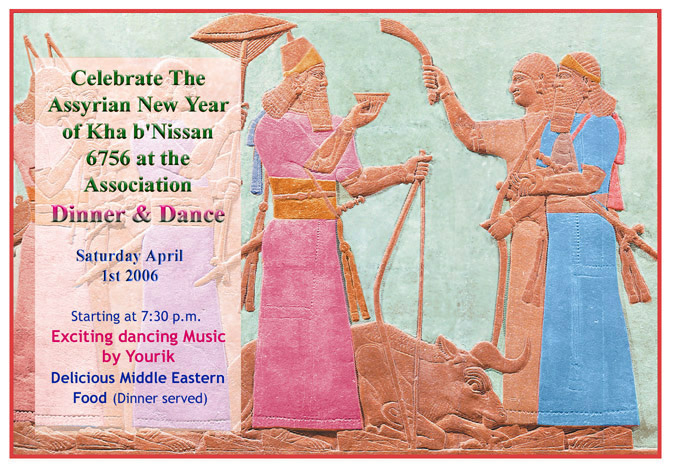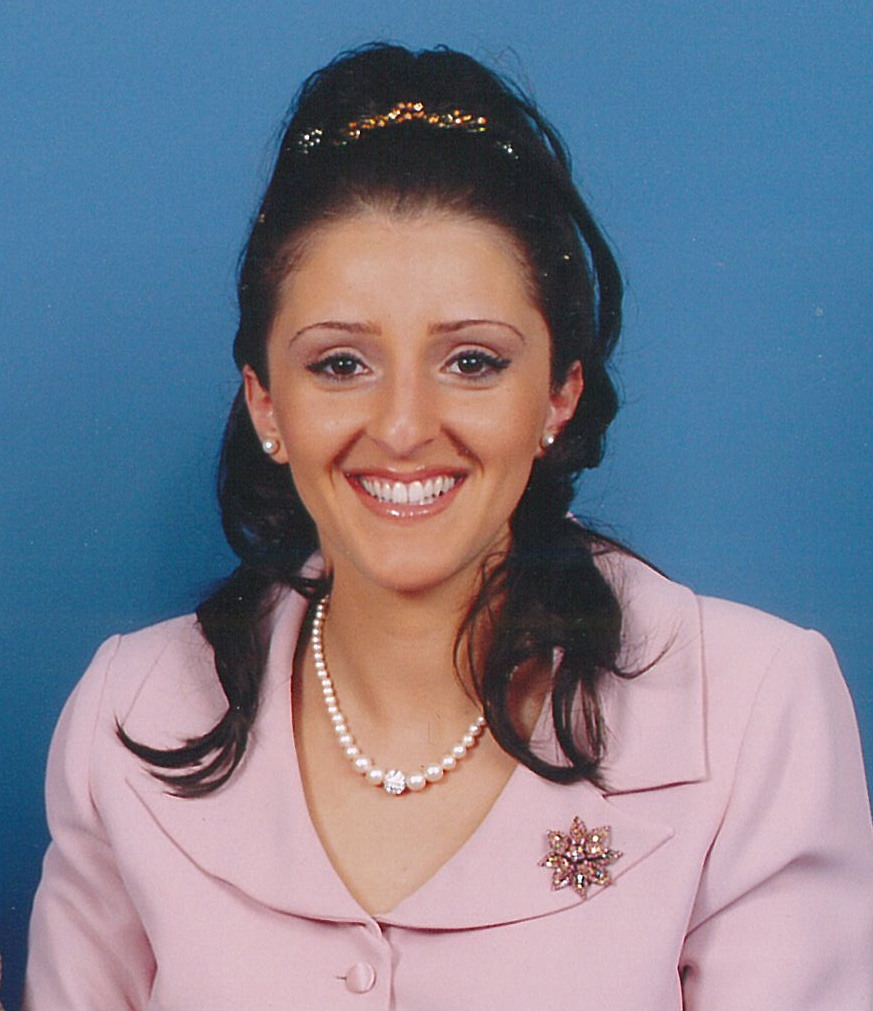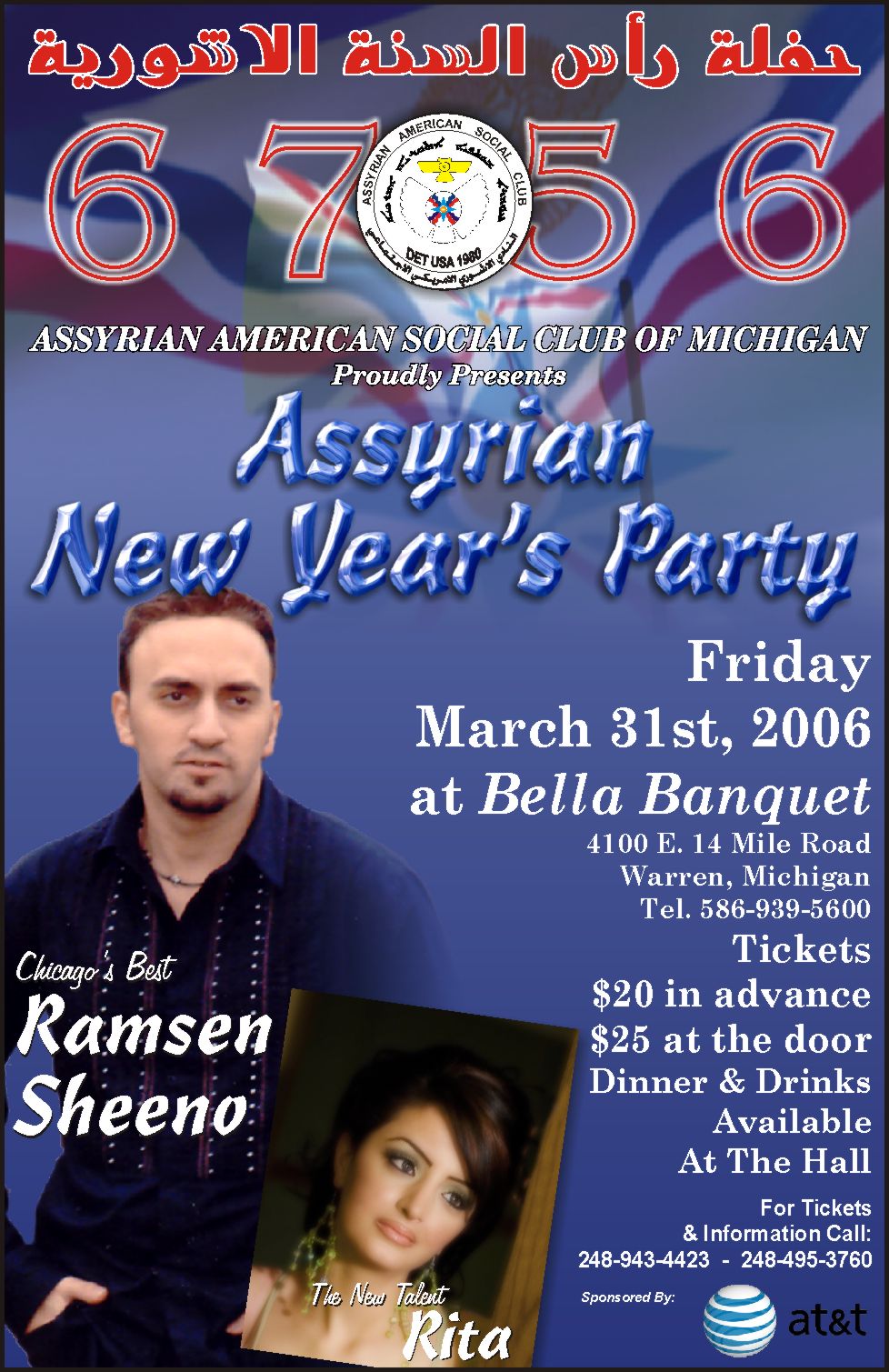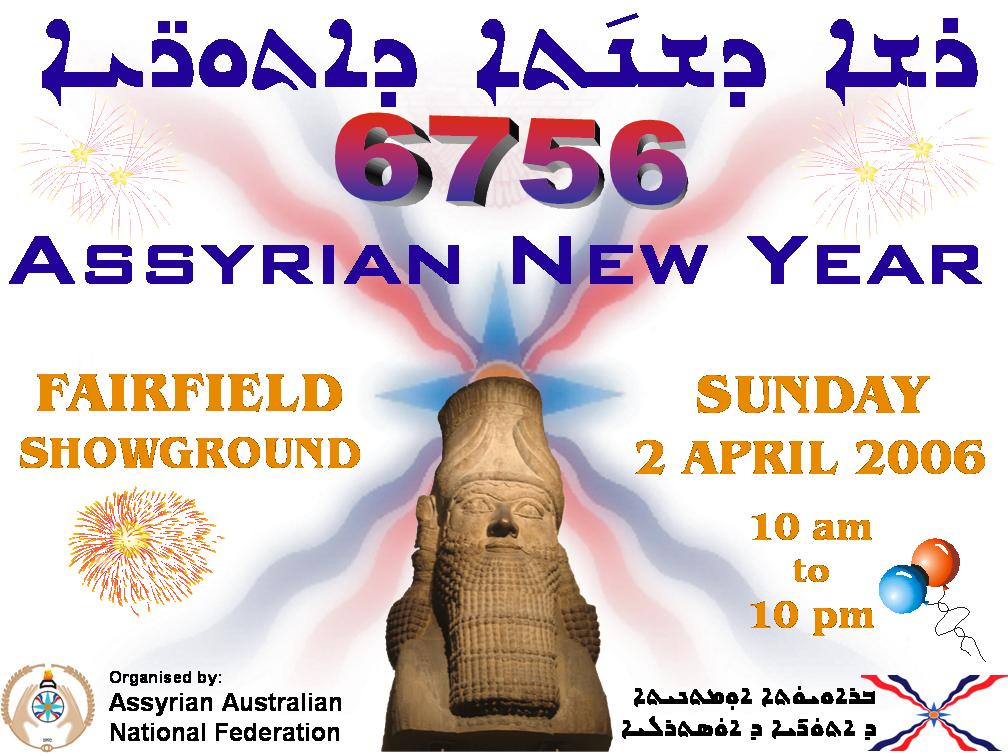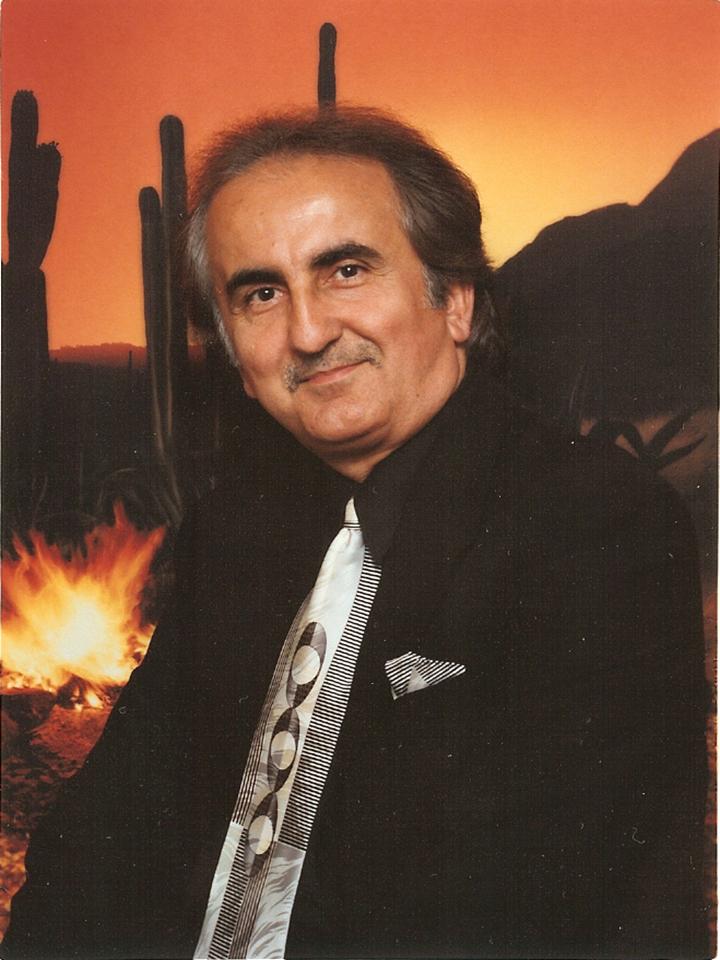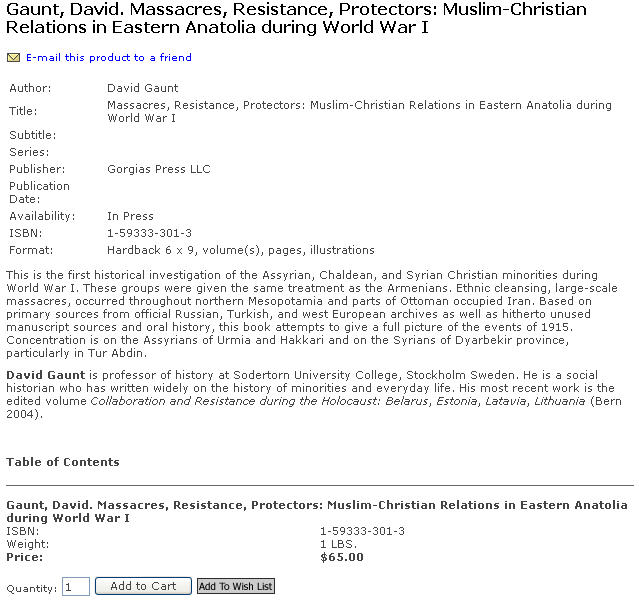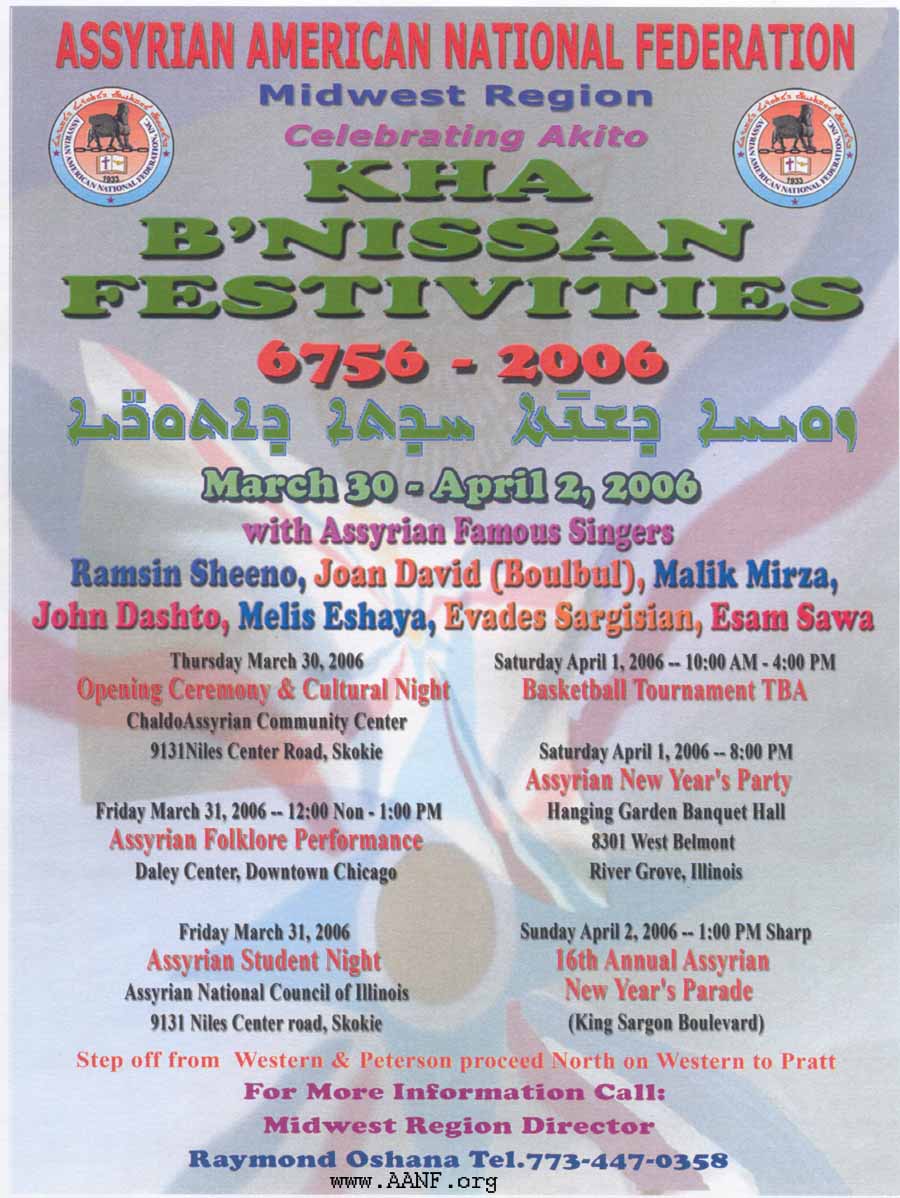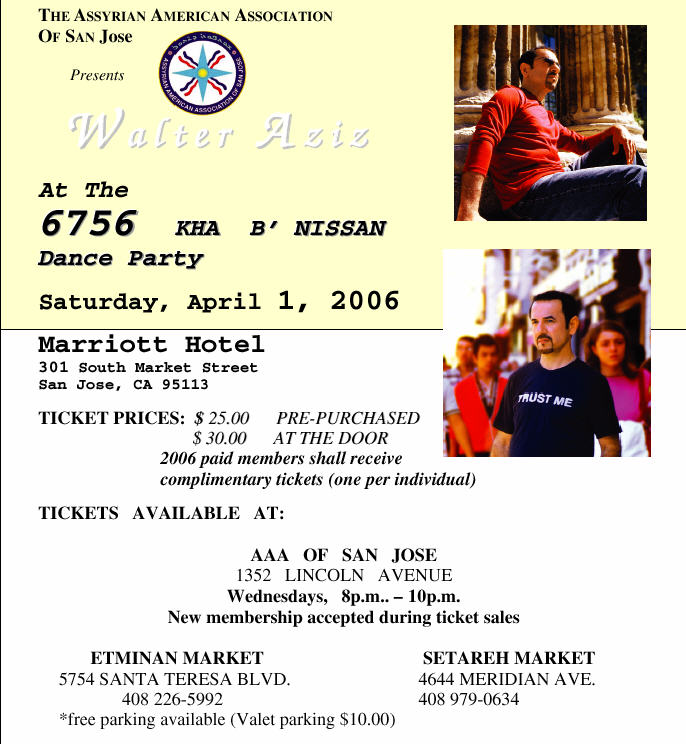|
Volume XII |
|
|
|
Tel 202-349-1429 | Fax 1-415-358-4778 | zcrew@zindamagazine.com
1700 Pennsylvania Avenue. NW Suite 400 Washington, DC 20006 U.S.A. |
|
|
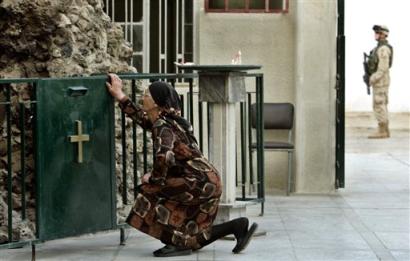
|
Safe Haven
or
Self Determination? |
|
|
|
A Safe Haven vs. Self-Administrative Region |
Fred Aprim |
|
|
Churches in Turkey to be Renovated
The Plight of Iraqi Christians |
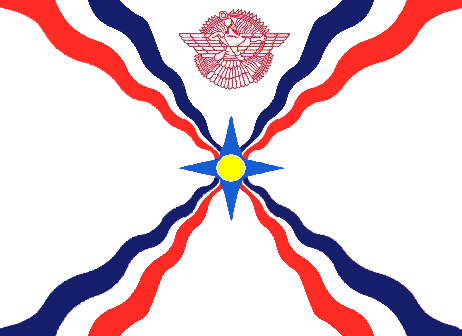 |
|
|
A Communiqué of the Assyrian Church of the East
Nuri Kino Awarded "Assyrian Of The Year" Prize
3 Years of War Wither a Family's Seed of Hope |
|
|
|
|
|
Some Clarifications on Recent Seyfo Film Documentary |
Click to Learn More
ZINDA CALENDAR
ZINDA ARCHIVES |
|
|
The Syriac-Aramaic Language of the Qur’an
Spring 2006 Assyrian Language Classes in Chicago
AANF Kha b'Neesan Celebrations in Fairfield |
|
|
|
And So the Jews Call Their Script "Ketuv Ashuri"
St. Elia Monastery, Dair Mar Elia
Death for “Apostates” and “Sodomists” |
Gabriel Afram
Joseph Odisho Bishabue
Andrew G. Bostom M.D. |
|
|
Assyrian Youth Wins MTV Trip to Africa |
|
|
|
The Lighthouse
Feature Article
|
|
The Future of the Assyrians of Iraq:
A Safe Haven vs. Self-Administrative Region
Fred Aprim
California
The strategy of the Assyrians (ChaldoAssyrians) in Iraq shifted after the churches bombings in Baghdad and Mosul on August 1 and then other bombings that followed in September 10, September 11, October 16, November 8, and December 7, 2004. The churches bombings continued in 2005. A church was bombed on July 16 in Ramadi and another on November 2, 2005 in Kirkuk. Additionally, Christian business owners and students began to be targeted in their working places and in universities. Christian women began to receive threatening notes to wear the hijab (Muslim veil). Persecution against the Assyrian Christians increased considerably by Islamists and by Kurds who began to interfere in Assyrians' internal national and political affairs.
Several efforts to protect the Assyrians were organized worldwide, including:
- On December 8, 2004 and in a 90-minute debate in the House of Commons, Stephen Pound MP called on the British government to help bring about the setting up of an autonomous administrative region in Iraq for the ChaldoAssyrians. Russell Brown MP and Dr. Robert Spink MP were among several MPs who backed Stephen Pound's call for much more support by the British government for Iraq's besieged Christians.
- On Monday, January 24, 2005, Lord Carey, the former Archbishop of Canterbury, launched a campaign to save the ancient Assyrian people of Iraq from extinction. Lord Carey joined scholars and members of the Assyrian community in London at the House of Lords to launch a campaign raising awareness of the plight of Assyrians. He said: “In recent months and years churches and monasteries have been attacked and people have been killed. Professor Simo Parpola, an expert on Assyrian culture, told the meeting that the current violence was on a par with the massacres during the First World War when 250,000 were killed.
- Chris Bowen, the Federal MP for Prospect in Australia in collaboration with the Australian branch of the Assyrian Universal Alliance (AUA) tabled a petition in March 2005 in Australian Parliament supporting a plan for a safe haven to be created in Iraq for persecuted minorities.
- On July 6, 2005, the United Kingdom Branch of the Assyrian Democratic Movement (ADM) in conjunction with the Jubilee Campaign via Lord Hylton organized a debate at the House of Lords. The following was the question tabled by Lord Hylton at the House of Lords: “Lord Hylton to ask Her Majesty’s Government what steps they will take to protect the legitimate interests of the ChaldoAssyrians and other religious and ethnic minorities in Iraq.”
The above examples show that some of these efforts called for a safe haven while others called for a self-administrative region in the historic Assyrian lands of the Nineveh Plains, Nahla, Sapna, Barwari, Amadiya, Dohuk, Zakho, Arbil, and other historic Assyrian regions in northern Iraq. Few Assyrian nationalists went farther and demanded autonomy in Assyria (northern Iraq); they argued if Kurds have it, why not Assyrians!
The ADM, as the only legitimate representative of the ChaldoAssyrians in Iraq, through its landslide victory in 1992 in northern Iraq No-Fly-Zone regional elections and then later in the January 30 and December 15, 2005 Iraqi national elections, made its stand clear. The ADM and Mr. Younadam Kanna rejected the concept of a safe haven for the Assyrian (ChaldoAssyrian) Christians of Iraq. Other ADM leaders confirmed this stand. Mr. William Warda lately rejected the safe haven concept, however, he welcomed a self-administrative region linked to the central government in Baghdad.
Safe Haven and the International Law
The 1949 Geneva Convention concerning the Protection of Civilian Persons in Times of War is considered as the first attempt to define the guiding principles of a safe haven policy.
The 1951 United Nations Refugee Convention (UNRC) spells out the obligation of states toward refugees and the rights of refugees. Article 33 of the 1951 UNRC is very important, it states: "Contracting State shall expel or return ("refouler") a refugee in any manner whatsoever to the frontiers of territories where his life or freedom would be threatened on account of his race, religion, nationality, membership of a particular social group or political opinion." The non-refoulement or the "Prohibition of Expulsion or Return" doctrine is central to refugee protection and is at the basis of asylum policy. However, in recent years the reliance on asylum policy as the main protection tool has been questioned, since many governments, including European, have shied away from their legal duty because of the high burden of refugees among other things.
The plight of the Assyrian refugees around the world and others who are categorized as "Internally Displaced Persons" (IDPs) within and outside Iraq must be resolved. IDP is defined as "persons who have been forced or obliged to flee or to leave their homes or places of habitual residence, in particular, as a result of, or in order to avoid the effects of, armed conflict, situations of generalized violence, violations of human rights, or natural or human-made disasters, and who have not crossed an internationally recognized state border." Hundreds of thousands of civilian Assyrians have been displaced from their original homes due to the Kurdish/Iraqi government armed conflict and the Arabization policies of Saddam Hussein. Later, it was because of the three Persian Gulf Wars of 1980-1988 (Iran-Iraq), 1991, and 2003 and finally by the Islamist threats on the Assyrians' personal lives and attacks on their churches.
Could the Assyrian refugees in Jordan and Syria and those displaced, whether by Iraqi governments or by the Kurdish unfair policies, return to their original homes? Do the ChaldoAssyrian Christians in Iraq have a chance to live and coexist among Islamists and ultra-nationalists Kurds?
What is a Safe Haven?
A safe haven is a designated area that holds within its boundaries a threatened people. There are many contingencies with this plan including high security, disarmament, and movement of individuals.
Problems associated with safe havens, include:
- The Assyrians, unlike the Kurdish example of the 1991 safe haven, are scattered throughout Iraq; they would need to leave their homes and villages to live in what could be, but not necessarily, a tent city. The ones that don’t leave their homes become isolated from the rest of the community and be targeted. Furthermore, other people could occupy the deserted Assyrian houses and the owners may find great challenges to reclaim their properties in the future.
- The issue of protection is of great importance. The example of Rwanda, Somalia, and Bosnia must be considered. The ineffective disarmament of Hutus in Rwanda, for example, made the camp a security threat and led the Rwandan government to feel endangered by it.
- The safe haven for Christians in Iraq could be interpreted as a Christian/Muslim conflict, which could inflame the already heated conflict around the world, especially after the Danish Jyllands-Posten Prophet Mohammad cartoons controversy. Chances are that it would have a negative ramification on Assyrians in neighboring Muslim states as well.
- The safe haven is neither sustainable over time nor does it actually solve the problem. Many analysts have argued that the world community should scrap the current safe haven policy. Others have supported a restructured safe haven policy, one that is closer to its original 1949 definition, but surely not with its current applications. Safe havens can be a tool to reduce hardship, but they definitely do not resolve the original predicament that produces violence. The sustainability of a safe haven regime will depend on how quickly an agreement can be reached to resolve the conflict.
Safe Havens and the Recent Concept of the "Right to Remain"
On March 31, 2003, thousands gathered outside the Bosnian town of Srebrenica for a mass funeral, commemorating more than 7,000 men and boys slaughtered when the Serbs attacked the then U.N. designated safe area in 1995. The massacre highlights the uncertain value of safe haven operations throughout the 1990s. Of course, there have been successful safe havens, such as the one established in Shanghai in the 1930s, during the Second Sino-Japanese War. That safe haven, which resulted from negotiations between the parties, sheltered a quarter of a million Chinese. However, such non-military zone, based on the consent of many parties, has not often been implemented or achieved in many other examples.
Safe haven policies have led the United Nations High Commissioner for Refugees (UNHCR) to address the needs of people other than refugees. Indeed, in recent publications this international organization describes its policy as proactive, homeland oriented and comprehensive. This development is closely linked to the promotion of the concept of the "right to remain" over the more traditional "right to flee." This mechanism was designed to solve the problem of countries being increasingly reluctant to receive refugees on a large scale. It offered to eliminate the causes of refugee movement by protecting individuals in their homeland.
For Assyrians, the safe haven was more appropriate to pursue in 1991 and as the United States offered it to the Kurds. Today, it is not advisable by the U.S., Great Britain, and the United Nations.
Self-Administrative Region
L i n d a B a d a l o f |
 |
I'm just a phone call away!
24200 Magic Mountain Pkwy.,105, Valencia, California 91355
Direct Phone: (661) 287-3200 x3468 Cellular: (661) 645-4290
Email: LindaBadalof@SCVFineHomes.com
|
The concept of self-administrative region for the Assyrians (ChaldoAssyrians) is much desirable and achievable since it is already guaranteed in the Iraqi Constitution. Article 121 of the constitution states: "This Constitution shall guarantee the administrative, political, cultural and educational rights for the various nationalities, such as Turkmen, Chaldeans, Assyrians and all other components. This will be organized by law." Mr. Warda's statement referred to in the beginning of this article was referring to the establishment of a new governorate to the Iraqi existing 18 governorates. This new governorate is to include the historic Assyrian towns and villages in Nineveh Plains where Assyrians could self-administer and protect themselves. Of course, there are some towns and villages around the Nineveh Plains that are not inhabited by Assyrians completely while other smaller Iraqi ethnic groups have a majority such as Yezidis and Shabak. This should not present any problems since the new governorate (Assyria), would be a geographically based and not ethnically based. Assyrians, Yezidis and Shabaks have lived in peace side by side for centuries unlike the Assyrians' experiences with the Kurds. The Kurds have massacred Assyrians and Yezidis and usurped their lands and homes. The concept of self-administrative region seems to be ideal.
Many Assyrians in Iraq assert that it would be better if the new governorate (Assyria) was protected by the United Nations or linked to the Central Government in Baghdad; however, recent sources indicated that it is more likely that it would be linked to the Kurdish Regional Government (KRG). The option of a "Christian administrative region" is, according to NINA News, pushed by Barazani's KDP and Talabani's PUK. Few Christian KDP members in northern Iraq and certain Assyrian clergymen in the Diaspora back-up the plan. The plan is to have a "Christian region" linked symbolically to the KRG for a short period of time, but it would be annexed later completely to what would be Kurdistan because it would be easier for Kurds later to usurp that region and make it part of their future state since the Assyrians are weak, but if the region was linked to Baghdad central government it would be harder to overtake. In fact, the Kurds have initiated that plan already by opening KDP offices in towns that are of purely or majority Assyrians and even in certain towns that do not have Kurds in them, intimidating the local inhabitants, raising the Kurdish flags instead of the Iraqi flags, and forcing the Kurdish language on the Assyrians.
A March 2006 unscientific poll by Zinda magazine asked how Assyrians envisioned the status of the proposed Assyrian self-administrative region in Nineveh Plain. 586 people participated in the poll. The poll showed that only 4% of those who participated approved the KRG control, meanwhile more than 56% approved a UN supervision and 24% approved the link to Baghdad. The rest were not sure or have no opinion.
There is a lot at stake here and the Assyrians must evaluate this new development and decide who must be in control of the negotiations with the Allies and Iraqis. This is a political and national matter and it should be discussed through the Assyrian political institutions. Church leaders must not interfere with national matters. Patriarchs and bishops must not hold separate meetings about this issue with the Kurds or any other sides; however, their opinion should be considered as Assyrian individuals. Any concerns and ideas that clergymen might have should be communicated between the Assyrian politicians and the clergymen themselves without the interference of any foreign elements. What we have seen unfortunately are separate meetings between Barazani and Talabani with various Church of the Assyrians leaders. Such meetings include that of November 2005 between Talabani and Mar Emmanuel Dally, Patriarch of the Chaldean Catholic Church, in the Vatican and the October 2005 between Barazani and Mar Dinkha, Patriarch of the Assyrian Church of the East, in Washington D.C. and another few weeks back between Mar Dinkha and Sargis Aghajan, Deputy Prime Minister of KRG, in Chicago. If the patriarchs were negotiating with Kurdish political leadership, Assyrians (ChaldoAssyrians) could reasonably be considered as dhimmi people just as they were in the early Islamic, Sassanid, Abbasid, and Ottoman eras when patriarchs were the supreme head of the community and they negotiated the affairs of the community with the state. Again, this is an effort by the Kurds to undermine and marginalize the Assyrian national leadership in Iraq represented in the ADM, which won majority votes in three separate elections and would spell a disaster for future Assyrians as the map of the Middle East is being redrawn.
Final Thoughts
While the plan for a self-administrative region is achievable, other steps must be taken to bring the chapter to a closure. Nobel Prize Winner Nageeb Mahfooz wrote: "if the tyrant and his comrades do not stand trial before an international tribunal, then values have become meaningless in this life." Two tyrants in modern Iraq have contributed significantly to the Assyrian present pathetic predicament, Ba'athist Saddam Hussein and Kurdish warlords KDP's Mas'uod Barazani and PUK's Jalal Talabani. While an Iraqi court is in session to deal with the first, the second, while an Iranian born, is the president of the northern Iraq Kurdish regional government and the third is the President of Iraq. The KDP has not only been the reason for the loss of many historic Assyrian lands in northern Iraq, it has been the reason behind many still unresolved assassinations, murders, rapes, and acts of oppression and persecution against the Assyrians. The world must remember that it was Mr. Barazani who invited Saddam Hussein and the Iraqi army to enter Arbil in 1996 and murder many fellows PUK and other non-KDP Kurds.
References:
- http://www.alitijahalakhar.com/archive/198/news.htm
- http://www.zowaa.org/ns/n18306-3.htm
- The News-Fairfield City Champion Newspaper. Issue of February 2, 2005
- http://www.ninanews.com/indexar.php?akcija=article&no=6856
- http://www1.umn.edu/humanrts/instree/v1crs.htm
- http://www.unhcr.org.uk/info/briefings/basic_facts/obligations.html
Sophie
- aspeslagh. Safe Havens. See http://www.beyondintractability.org/essay/safe_havens
- Notes by Gaby Kiwarkis on http://www.aina.org/bbs/index.cgi
- www.zindamagazine.com
- www.ankawa.com
|
|
Good Morning Assyria
News From the Homeland
|
Churches in Turkey to be Renovated
Courtesy of the Turkish Daily News
25 March 2006
A decision made by Turkey's Foundations Department to renovate six churches, one monastery and a synagogue was praised by minority community leaders on Friday.
Among the sites slated for renovation are places of worship belonging to the Greek Orthodox, Syriac Christian, Greek Catholic, Armenian Orthodox and Jewish faiths.
The Foundations Department began its review of important sites around the country two years ago and produced an emergency action plan involving 750 heritage buildings out of 18,500 such sites in Turkey.
Turkey's Armenian Patriarch Mesrob II praised the Foundations Department's decision, adding, “This shows there is no discrimination.”
He said it was a goodwill gesture he hoped would continue into the future.
The Plight of Iraqi Christians
Courtesy of the New Republic
3 April 2006
By Lawrence F. Kaplan
Fadi has had it with Iraq. At his family's home in Baghdad, the Christian university student (whose last name has been withheld to protect his
family) elaborates in fluent English. "There is no future for Christians here," he says. He knows this firsthand. Last year, four men drove up to his family's house and snatched his twelve-year-old nephew off the street.
Targeted for riches that few of them actually possess, Christians routinely disappear from the sidewalks of Baghdad. "We have no militia to defend us, and the government--they do nothing," Fadi says. A day after the abduction, the captors phoned Fadi's family, demanding $30,000. If his family failed to cobble together the ransom, Fadi knew what would come next. His nephew would be shot or beheaded.
After Iraq's Baathists seized power in 1968, they celebrated by stringing Jews up in a Baghdad square. With the remnant of Iraq's Jewish population having long since fled the country, Christians have become today's victims of choice. Sunni, Shia, and Kurd may agree on little else, but all have made sport of brutalizing their Christian neighbors, hundreds of whom have been slaughtered since the U.S. invasion. As a result, Iraq's ancient Christian community, now numbering roughly 800,000 and consisting mostly of Eastern rite Chaldean Catholics and Assyrian Orthodox Christians, dwindles by the day. According to Iraqi estimates, between 40,000 and 100,000 have fled since 2004, many following their own road to Damascus across the Syrian border or to Jordan, while many more have been displaced within Iraq. As for the country that loosed the furies against them, the United States refuses to provide Iraqi Christians protection of any kind.
BELINA GIVARGIS |
|
Mary Kay
Independent Beauty Consultant
(703) 772-8064
bgivargis@marykay.com

Click Image to Learn More
|
From his synod in Baghdad, the most prominent Christian clergyman inIraq,
Chaldean Patriarch Emmanuel Delly, denies the obvious. "There is no persecution of Christians," the septuagenarian archbishop insists. "All Iraqis have problems." The fiction has become canonical among Iraqi Christian leaders, who maintain it to avoid inciting their tormentors. Many members of Iraq's clergy, for example, dismiss as gross exaggeration reports that tens of thousands of Christians have fled Iraq.
But, however much the clergy may deny it, Iraqi Christians suffer for their faith. Along with kidnappings and assassinations, church bombings--beginning with the destruction of five churches in August 2004--have become a staple of Christian life in Iraq. To disguise their faith, Christian women, particularly in Iraq's south, tuck their hair under hijabs, while fewer and fewer attend church, performing Mass in homes and sometimes, like their ancient Christian ancestors, in crypts instead. Even the Kurds, so often depicted as saints in Iraq's morality tale, have taken to pummeling Christians; the Kurdish religious affairs minister said last year that "those who turn to Christianity pose a threat to society."
Commenting on a recent pogrom against Christian students in Mosul, Yonadam Kanna, the only Christian elected to Iraq's new parliament, says, "The fanatics blame us for doing nothing. They blame us for being Christian."
The blame accrues, in part, because of real and imagined ties to the West and to the Western power occupying Iraq. There is, in truth, a cultural affinity between Iraqi Christians, many of whom speak English (and, as such, account for a large percentage of the U.S. military's interpreters), and the mostly Christian soldiers occupying their country. "[Local Christians] were very supportive of having us in Mosul," says Colonel Mike Meese, who served with the 101st Airborne Division in the heavily Christian city. "They'd have our soldiers go to Mass with them." But, as soon as their American protectors departed, the city's Christians became targets--their churches sacked and their archbishop kidnapped. In Baghdad, too, insurgents routinely execute Christians who work alongside the Americans. Threatened by her neighbors, a Christian friend of mine who worked in the Green Zone quit her job and today rarely leaves her house.
To the lengthy indictment of Christians, their persecutors have also added the charge of proselytizing. Unlike American soldiers, who mean to save Iraqi lives, the American evangelicals who followed on their heels mean to save Iraqi souls. There is a difference. Evangelizing to Iraqis carries with it risks that evangelizing to, say, Latin Americans does not. The infusion of pamphlets and missionaries from organizations like the International Mission Board of the Southern Baptist Convention enrages Iraqi Muslims, who, Iraqi Christian leaders claim, increasingly conflate their congregants with "the crusaders"--and, too often, treat them as such.
"The evangelicals have caused such problems for us," says Kanna. "They make the Sunni and Shia furious."
Even though Iraq's Christians suffer in the name of their American co-religionists, their fate seems not to have made the slightest impression on much of the evangelical establishment. Their websites and promotional literature advertise the importance of creating new Christian communities in Iraq while mostly ignoring the obligation to save ancient ones. Nor, with a few exceptions, have mainstream church leaders in the United States broached the subject, either. Dr. Carl Moeller, the president of Open Doors USA, an organization that supports persecuted Christians abroad, pins the blame on Christianity's own sectarian rifts. "The denominations in Iraq aren't recognized by Americans," he explains. "The underlying attitude is, 'They're not us.'"
The abysmal plight of Iraq's Christians, needless to say, long predates the arrival of the Americans. Since the first century, when Christianity first came to Nineveh province, Iraqi Christians have been cursed by geography.
With its fields of mud burnt red by the sun, much of Nineveh--the ancestral home to a large number of Assyrian Christians that runs from Mosul to the Syrian border in Iraq's northwest corner--resembles a Martian landscape.
Thousands of feet above the plains, a small U.S. outpost atop the Sinjar mountain range shines at night, a beacon to many of the Christians, Yazidis, and other persecuted minorities who populate the province below, a number of whom initially greeted the Americans as their saviors. But, having been massacred over the centuries by Ottomans, Kurds, and Arabs alike, most Christians know better than to rely on the goodwill of others.
Nor is this knowledge merely the result of their experiences under foreign rule. Even though the Christian presence in Iraq predates the arrival of Islam, in the Iraqi Muslim imagination, Christians will always be emissaries of the West. Because they operate a disproportionate share of Iraq's liquor, music, and beauty shops--industries deemed sinful in various interpretations of Islam--insurgents accuse them of embodying the licentiousness of all things American and have burned hundreds of liquor stores to the ground. Where Iraq was once awash in pop music CDs sold by Christian vendors, a more recent CD circulating in Mosul features the beheading of Christians.
It was against this backdrop that Fadi's family raced to save his kidnapped nephew from a similar fate. Luckily, Fadi's father, a doctor, was able to produce the $30,000 ransom. Eight days after his abduction, the captors released Fadi's nephew. But the ordeal shook his family so badly that, a month later, they spirited the boy off to Jordan. "If, today, we all had a place to go, tomorrow there wouldn't be a Christian left in Iraq," Fadi says.
As for Fadi himself, who first applied to leave Iraq in 1998 while Saddam Hussein was in power, last year's kidnapping made him even more anxious to flee. With the doors to the United States sealed shut, he placed his faith in other Western countries. While over 40,000 Iraqi Christians have fled their homeland since the invasion, last year the United States permitted fewer than 200 Iraqis to immigrate. As for the thousands of remaining Christian refugees, until recently, the U.N.'s High Commissioner for Refugees didn't even bother referring their cases to the United States, knowing we had no inclination to take them in.
Their case files amount to proof of Washington's callousness. There is the Iraqi American whose Christian sister saw her husband gunned down in the street. Following the assassination of two more family members, the sister fell into a crippling depression, unable to care for her two-year-old child. Caught up in a bureaucratic tangle, her American relatives have gotten exactly nowhere. Another sister of an Iraqi American, a Christian woman with four children, lost her husband, killed while serving as a U.S.
military interpreter. Her family, too, has been reduced to pleading her case before unconcerned State Department officials. A heartfelt advocate for Iraqi Christians, Representative Jan Schakowsky, a Democrat from Illinois, calls embassies, by her account, "at all hours of the night," but "the policy since the war began is, 'We're not granting asylum.' ... There is no processing of refugees from Iraq." The reasons derive from post-September 11 security restrictions and, in the telling of a senior administration official, from the fiction that Iraqis, now liberated, no longer endure systematic persecution.
Fortunately for Fadi, other Western governments have offered a more candid assessment, and, after seven years of waiting, one just informed him he will be granted his visa. He can barely contain his glee. "I feel happy because I go to a new place where I feel free," he says.
But his case counts as a rare exception. Before leaving Baghdad last month, I got a taste of the desperation felt by Iraqi Christians left behind.
Samira, a sad woman in her fifties who comes once a day to cook for an Iraqi friend, showed me a photograph of a woman in her thirties. She had a favor to ask: Would I marry her daughter? The proposition had nothing to do with me, per se. She simply wants to get her Christian daughter out of Iraq.
Last year, insurgents murdered Samira's son. As a sign of respect, his Muslim friends transported the body to Najaf for burial in the Shia holy city. A kind gesture, to be sure, but Samira wants her son buried in a Christian cemetery. The son's Shia friends refuse to surrender his body, and, not being Muslim herself, there is no one to whom she can effectively--or safely--plead her case. Like most Iraqi Christians, she has nowhere to turn.
|
|
News Digest
News From Around the World
|
|
A Communiqué of the Assyrian Church of the East -
Western U.S. Dioceses
For Immediate Release
15 March 2006
Los Angeles, California
Communiqué of the Holy Apostolic Catholic Assyrian Church of the East
Clergy Council of the Dioceses of the Western U.S.A.
By the abundant mercies of Jesus Christ our Lord and God, and with the blessing of His Holiness Mar Dinkha IV, Catholicos-Patriarch of the Assyrian Church of the East all of the parish priests of the dioceses of the Western California under the jurisdiction of His Grace Mar Odisho Oraham and the Western U.S.A. under the jurisdiction of His Grace Mar Aprim Khamis of the Assyrian Church of the East gathered in council from 13 to 15 March 2006 at the premises of the St. Mary’s Assyrian Church, Los Angeles, California. The council sessions were held in an intense spirit of prayer, brotherly love, charity and collaboration under the guidance of the Holy Spirit.
The clergy who attended the council from both dioceses are as follows:
- Very Rev. Archdeacon Nenos Michael, parish priest of Mar Narsai Parish (San Francisco) and the representative of His Grace Mar Odisho Oraham, bishop of the Western California diocese;
- Rev. Auchana Kanon, parish priest of Mar Gewargis Parish (Ceres);
- Rev. Jameel Wardah, parish priest of Mar Addai Parish (Turlock);
- Rev. Kando Kando, parish priest of Mar Zaia Parish (Modesto);
- Rev. George Bet-Rasho, parish priest of St. Mary’s Parish (Los Angeles);
- Rev. Fredrick Hermiz, parish priest of Mar Patros Parish (Phoenix);
- Rev. Antwan Latchen, interim-parish priest of Mar Yosip Parish (San Jose);
- Rev. David Royel, St. Mary’s Parish (Los Angeles);
- Rev. Gabriel Brakhia, parish priest of Mar Polos Parish (Orange County);
- Rev. Khoshaba Shleemon, parish priest of Rabban Hurmizd Parish (San Diego);
- Rev. Aprim Younadam, parish priest of Mar Benyamin Shimun Parish (Las Vegas), prevented from attending but standing in solidarity with the Clergy Council.
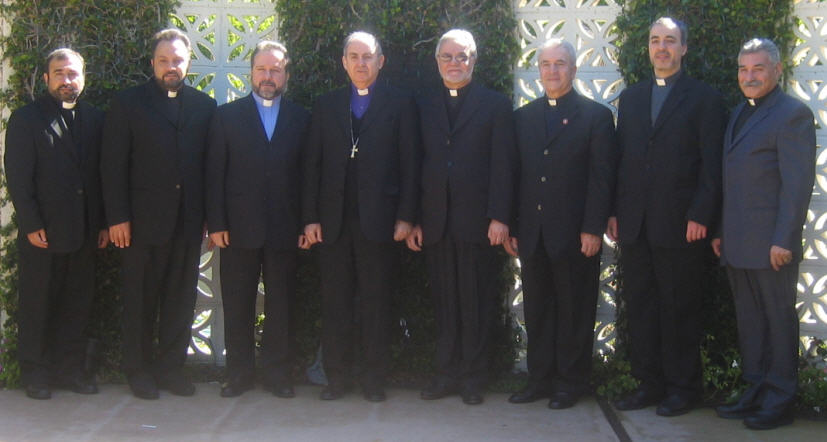 |
Assyrian Church of the East parish priests of the dioceses of the Western California under the jurisdiction of His Grace Mar Odisho Oraham and the Western U.S.A. under the jurisdiction of His Grace Mar Aprim Khamiswho atteneded a recent gathering between 13 and 15 March 2006 in Los Angeles, California. |
The Clergy Council deliberated on a number of vital issues facing the Assyrian Church of the East at large in the present days. The major issues discussed were the status of the youth associations of the various parishes, the attendance of the faithful for Church services and the various other activities and building projects in which the parishes are engaged. We give glory to God to see that numerous signs indicate success and a surge of support from the faithful at large of their Holy Church under the guidance of His Holiness Mar Dinkha IV, Catholicos-Patriarch. The Clergy Council further deliberated on issues that are presently at odds with the Church, and we pray that all the faithful of the Church join us in fasting during this holy, penitential season of the Lord’s Fast that God’s peace may once again reign in the hearts of all so that these bleak clouds may pass from the Holy Church. It was reiterated that the Church’s doors and arms are open to all her children, and She calls all to be reconciled and to be counted once more as Her children, born and re-generated through Her bosom in the Sacrament of Holy Baptism. We too would ask that the faithful of the Church respect one another as brothers and sisters in the one and same Lord—Jesus Christ.
The Clergy Council would like to call all of the faithful sons and daughters of the Assyrian Church of the East to publicly and actively demonstrate their support for the Church of their forefathers—the Church of two millennia of martyrdom and witness to the salvific message of the Gospel of Jesus Christ! This support does not exclude the Holy Church’s respect for other Christian denominations, rather it is a living witness that the Assyrian Church has a unique place in the history of Christendom, and an equally unique role to play in the ecumenical dialogue in which the various Churches are engaged. Our message is one of peace, harmony and Christian fraternity among all the followers of Jesus Christ.
The Council further exhorts all Assyrian organizations, political parties and associations to be mediums of harmony and fraternity among all Assyrians, irrespective of their ecclesiastical or political affiliation. Since their work is a labor of love for the future of our beloved Assyrian people and nation, we exhort the political parties and cultural associations to actively demonstrate this harmony and to practically promote it among all Assyrians. We respectfully ask that all personal slander and mud-slinging cease immediately among our Assyrian political groups and associations, and that their various media in the form of TV, radio and internet communications be used as forums to promote the general good of the Assyrian people and not as forums of invective and slander. We call upon all our politicians and political groups to equally refrain from unwarranted public slander and invective against all prelates and clergy, irrespective of their Church affiliation, and to rather be peacemakers sowing the good seed of unity and harmony among all Assyrians. Only by such practical means can we promote a genuine and enduring unity among our people.
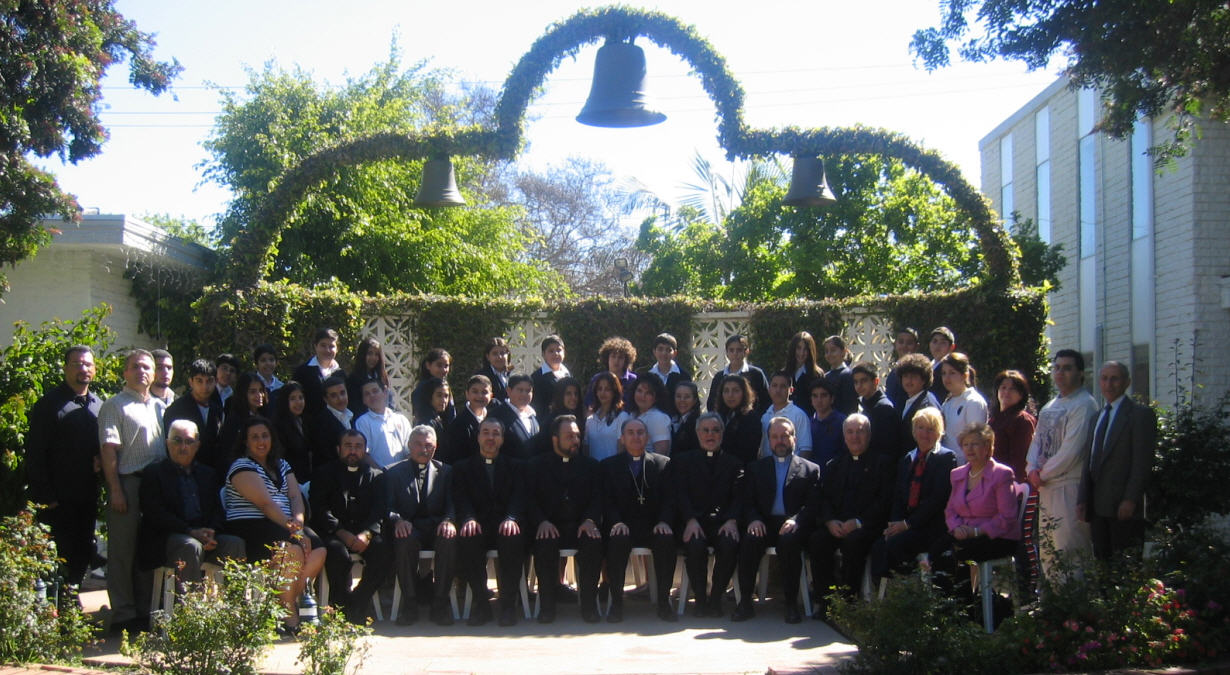 |
Assyrian Church of the East
Clergy Council of the Dioceses of the Western U.S.A. |
Finally, all of us clergy who have met in an atmosphere of brotherly love these past few days would like to publicly demonstrate our undivided support for our beloved Church—the Assyrian Church of the East—under the guidance of His Holiness Mar Dinkha IV, Catholicos-Patriarch. We further demonstrate our support of the Holy Synod and any and all decrees which it may issue.
May the Grace and Peace of our Lord Jesus Christ, the Love of God the Father and the Fellowship of the Holy Spirit be with us all, forever; Amen.
Nuri Kino Awarded "Assyrian Of The Year" Prize
A report by Afram Barryakoub from
Sweden
The multi-awarded journalist, Nuri Kino, was selected as the "2005 Assyrian of the Year" by the Assyrian Youth Federation of Sweden. The anouncement was made public during the annual meeting of the youth federation.
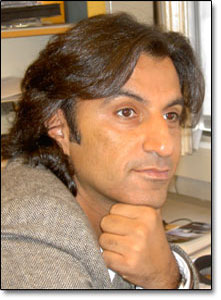 |
Assyrian journalist, Nuri Kino, is awarded the Assyrian Youth Federation of Sweden's "Assyrian of the Year" award. |
The “Assyrian of The Year” prize is each year awarded to a person who has contributed to the betterment of the Assyrian nation. Two former winners are Gabriel Afram, author of the Swedish-Assyrian dictionary and Father Yusuf Akbulut, the priest who spoke out on the Assyrian genocide (Seyfo) in Turkey.
Many of Mr. Kino's articles in leading newspapers of Europe evolve around the situation of the Assyrian nation. His latest documentary about the famous Assyrian soccer team “Assyriska” is now competing in the Beverly Hills film festival. The youth federation presented the prize to Nuri Kino with the following words: "With his razor sharp formulations, insight and knowledge he has, with his articles, newspaper reports, radio commentaries and TV documentaries, elevated the situation of the Assyrians to the international political arena..."
After recieving the prize and a check for ten thousand kronor (approx. $US 1300) Nuri Kino gave an emotional speech in which he emphasized the need to bring in more love in the Assyrian movement and to take care of one another. In the end, he announced that he is donating the entire check to Zelge, the fan club of the Assyrian football (soccer) team, “Assyriska”.
Nuri Kino also said: “I have followed many Assyrian groups during the years but I have never come across a group that never, never gives up, even when everyone else gave up as Zelge has stood firm in its support and work for their team”.
 Mr. Nuri Kino's documentary "Assyriska: A National Team without A Nation" will be competing at the Beverley Hills Film Festival between 6 and 8 April, 2006. For more information click here. Mr. Nuri Kino's documentary "Assyriska: A National Team without A Nation" will be competing at the Beverley Hills Film Festival between 6 and 8 April, 2006. For more information click here.
3 Years of War Wither a Family's Seed of Hope
Courtesy of the Los Angeles Times
25 March 2006
By
Louise Roug
Other Contributors were Borzou Daragahi and Shamil Aziz in Baghdad
(ZNDA: Baghdad) As U.S. forces made their way to the capital, Baher Butti sat alone in his house with the AK-47 that Baath Party officials had given him to guard his neighborhood. It was March 25, 2003, and the psychiatrist had just celebrated his 43rd birthday.
"The war on Iraq has started," he wrote in his diary. "I have not prepared myself to be a fighter but a doctor and a family man."
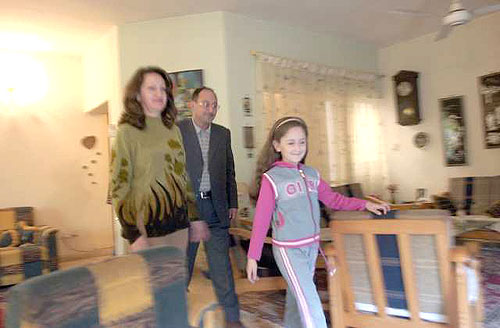 |
ISLAND OF NORMALITY: Balsam and Baher Butti and their 9-year-old daughter, Ula, live in a middle-class home in the Baghdad suburbs. The Buttis also have two sons, Sarmad, 17, and Fadhil, 20. Ula was injured when a bomb hit her school bus in May. (Saad Khalaf / LA Times) |
A man trained to heal the suffering of others, Butti would see trauma enter his own house in the three years to follow. Fighting and havoc would empty his church, claim the lives of friends and relatives and, finally, touch his 9-year-old daughter — leaving her scarred and traumatized after a bomb ripped through her school bus.
That March night, Butti described sneaking out from his forced guard duty to see his wife and three children at her father's home.
"I used a road that I thought was convenient to avoid the risk of bombings. I returned back very quickly to resume my duties," he wrote. "I am now in my house. I feel mentally exhausted."
Target practice had been part of Butti's high school curriculum, and Baath Party membership was almost mandatory for him to work as a doctor. But the idea of using a weapon to defend the regime repelled him.
"I feel afraid after I was put by the [party] in this silly role," he wrote. "I was overcome by the feeling of being a sheep on the way to the slaughterhouse."
Street fighting never came to his neighborhood. On April 6, Butti crossed the river and joined his family. Together on a rooftop they watched the tanks enter the city. His wife, Balsam, a more vociferous critic of Saddam Hussein's regime, greeted arriving U.S. soldiers with tea and biscuits.
The soldiers refused.
"We were so happy" that the soldiers had arrived, Balsam Butti recalled later. "But they were afraid of us."
Her husband, for his part, was bewildered by the sight of Americans riding their tanks through the streets of his city.
The idea that his country was occupied by foreigners made Butti uncomfortable. Still, a hope grew. With the Americans, perhaps a kind of progress would arrive.
Butti, a graduate of the Jesuit High School in Baghdad, quickly became involved in local politics, writing pamphlets and columns. He talked to journalists and pontificated on the meaning of democracy, tyranny and freedom.
He stopped keeping a diary. His writing — by necessity private during Hussein's regime — became public.
In June, three months after the invasion, Butti was still trying to articulate what was happening in his country.
"When people saw the statue [of Hussein] falling in Firdos Square, the mountains of oppression that were in their souls started to explode," Butti wrote with characteristic flair.
With Hussein gone, U.S. forces watched as Iraqis looted the city. Freedom meant "do what you feel like," he wrote.
He was still ambivalent about the Americans — "friend or an enemy?"
A few days after the invasion, his wife, an obstetrician, returned to her clinic. Their children, a girl and two boys, went back to school. And Butti resumed his job at Ibn Rushd Teaching Psychiatric Hospital, Baghdad's biggest mental hospital.
Psychiatry had been a neglected field in Iraq for decades. Butti and his colleagues maintained little contact with the outside world and relied on outdated theories and textbooks.
The psychiatrist dreamed of building a small clinic in Baghdad that would offer group therapy and counseling. He brought American doctors to Iraqi mental wards to show them Iraq's abysmal healthcare system. He sent funding proposals to the Coalition Provisional Authority, which ruled Iraq after Hussein's fall.
U.S. officials listened with sympathy but had no money for his project. Their priorities were first relief, then election campaigns and eventually security, he said.
As violence worsened, American and Iraqi officials moved into the Green Zone, a heavily fortified compound along the Tigris River. U.S. soldiers began to refer to the city outside as the "red zone." Baghdad was being divided.
Winter 2005 Issue of the Assyrian Star |
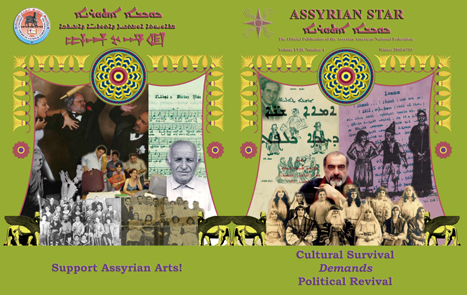 |
64 informative pages will be available in a few weeks
New 2006 subscribers receive the Theater Issue as Bonus
Subscription Rates:
USA ... $30
Canada ... $35
International ... $40
Institutional Subscribers ... $55
Send your check today to:
Assyrian Star
P.O. Box 2880
Worcester, MA 01613
Questions? theassyrianstar@aol.com
(Why not make a gift subscription to a loved one or friend?) |
"We used to meet them outside the Green Zone," Butti said of U.S. officials. "Then things became that we had to go to the Green Zone [because] they couldn't go out. Then our entrance to the Green Zone became very difficult."
Outside the compound, gunmen took over streets, kidnapping and killing Iraqis. Doctors and academics in particular became targets. By 2004, many of the doctors who stayed in Iraq carried guns as they made their hospital rounds.
Leaving the house became a gamble, said Butti, who refused to arm himself for work.
Instead of progress, he and his wife saw advancing irrationality. Baher Butti — a slight, balding man with a bookish air — observed the proliferation of faith healers. Balsam Butti — composed, beautiful and partial to charcoal-colored suits — noticed that more women were giving birth at home, unable to make it to the hospital because of curfews or violence. As a result, more babies were stillborn and more women bled to death during labor, she said.
"Collectively speaking, we have regressed," Baher Butti said. "I'm a believer in God, but it doesn't make me superstitious. But our people are becoming superstitious."
Fundamentalism also took hold. Arsonists torched the Buttis' local library. Liquor store owners were assassinated. Three gunmen shot Balsam Butti's cousin in the stomach as he stood behind the counter of his convenience store. His family believes he was killed for selling beer.
Under Hussein's secular rule, Iraq's Christians were allowed to prosper and practice their faith without much trouble. At Christmas, Iraqi Muslims would go out caroling with their Christian neighbors.
But in the new Iraq, Christians in the Buttis' neighborhood received death threats and fled. By Christmas 2004, pews at their local church were half empty. Extremists targeted barbers for giving Western-style haircuts and violating strict Islamic teachings by trimming or removing men's beards. Baher Butti forbade his teenage son to wear his hair the way he wanted it — spiky.
Violence closed in. Their world was shrinking.
Friends left the country. The Buttis no longer went swimming at the Al Wiya Club in downtown Baghdad, now nearly deserted. Eventually, they stopped visiting relatives living outside the capital.
The retreat into their middle-class home in the Baghdad suburbs was bittersweet. Suddenly, there was more time with each other and their children — 9-year-old Ula and her two brothers, 17-year-old Sarmad and 20-year-old Fadhil. Baher and Balsam's marriage blossomed.
On most nights, the family would gather in their cozy living room, watching their favorite TV shows — "Friends" and "The West Wing." Shipwrecked by the upheaval around them, they clung to each other and their island of normality.
Baher refused his family's advice: Abandon Baghdad, move abroad and start a new life. He believed his roots in Iraq were too deep. His grandfather had served as a minister of culture. Baher wanted to build his own legacy — the Al Janna, or Paradise, clinic.
On May 7, 2005, a bright Saturday morning, Balsam was standing in the kitchen rolling up dolmas. The phone rang and Sarmad picked it up. After a brief conversation, he turned to his mother. "Mama, Ula is in danger," he said. "She is in Al Kindi Hospital."
A bomb had ripped through the school bus carrying Ula and seven other girls from Dijla Primary School. Balsam, otherwise unflappable, panicked. She frantically called Baher, who had taken their car for repairs. Rushing to the hospital in a taxi, Baher prayed incessantly for his daughter's survival.
At Al Kindi — a dirty, depleted hospital downtown — doctors had taken Ula for X-rays, examining the damage done to her freckled face. They stitched her wounds without anesthetics.
When Baher found Ula, he showered her bruised and bloodied face with kisses. He thanked God that shrapnel had slashed his daughter's nose rather than her eyes, that only her lips, not her throat, had been slit open. He swept her up and took her to a plastic surgeon, a family friend, who immediately treated the girl. Eventually, the scars would disfigure only Ula's skinny arms.
"That day," Balsam said, "she blamed me because she didn't want to go to school but I had forced her to go."
Ula's nightmares, which she often remembered the next morning, added to her mother's feelings of guilt.
"During the first month, every day she would give us a segment of the incident, a phrase here and a phrase there," Balsam said. "She used to say: 'There was a tank beside us, and the tank was hit. The driver was injured.' In another segment she said: 'The girl beside me was silent. Why was she silent? Did she die or not?' "
Although some were seriously injured, all seven girls survived.
Later her daughter told her, " 'I don't want to remember,' " Balsam said. " 'I don't remember and I don't want to remember.' "
Baher let his daughter be. Better that she forgets, he thought, even if he could not.
On a recent spring day in Baghdad, traffic was at a standstill as trucks unloaded mountains of generators and washing machines — goods once unobtainable in Iraq.
A hot dog vendor did brisk business underneath a sign advertising the South Korean company LG and its slogan, "Life's good." Down a side street, a group of boys played soccer in a dusty field.
Around the corner in a garden, six female doctors and healthcare workers sat in the shade, talking shop. Baher Butti was listening in on their discussion. Behind him, a sign spelled out "Al Janna" — Paradise.
He had finally built it.
An Iraqi advertising executive, looking for publicity, had donated $10,000. Baher used the money to buy a modest house, creating a refuge for the afflicted. Upstairs, in an empty studio, a patient had been working on a painting as part of his therapy. The half-finished piece on the aisle showed soldiers on horseback attacked by lions.
"It's a small place, but it's just the beginning," Baher said, mixing pride and apology.
For him, however, it was the end — a seed of hope he could no longer sustain. After Ula's school bus was hit, the Buttis decided to leave Iraq. As soon as Sarmad finishes his exams, they will join relatives in the United Arab Emirates.
But that decision ruptured the family bond that had strengthened during the last three years of violence.
The older son, Fadhil, has refused to leave, convinced that he and his friends will be able to change Iraq for the better.
"It's my country," Fadhil said. "This is the place I was born, and I want to die here. I don't want to go outside. We — the students — we will change it. It's our duty."
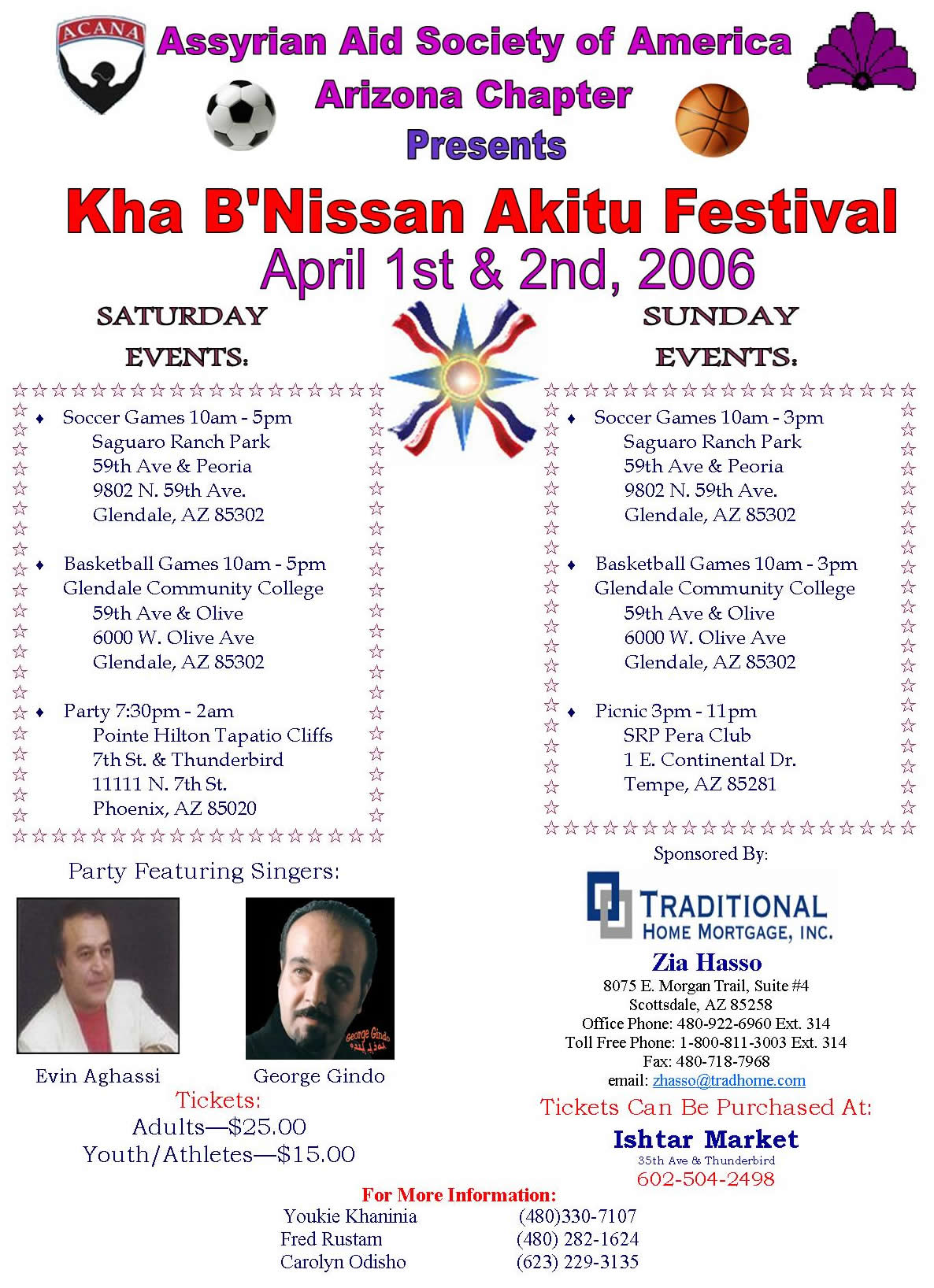
|
|
Surfs Up!
Your Letters to the Editor
|
Some Clarifications on Recent Seyfo Film Documentary
Robert Alaux
"Seyfo l'elimination"
Director
France
A text about the film "Seyfo l'elimination" was published in the last issue of Zinda Magazine dated 18 March 2006.
Neither I, the director, nor Nahro Beth Kinno, the writer, of this documentary had written or read this text, and it does not reflect my view about the documentary.
I want to emphasize several points:
- the number 750,000 victims that appears in this article is not in the film. We have to be very cautious about these kind of numbers. The highest number that is in the film is on the picture of the memorial built in Sarcelles, France where it is written: 250,000 AssyroChaldeans dead.
- The Turks and Kurds who live today are absolutely not responsible for what happened at the time of Ottoman Empire at the beginning of the XXth century. So this film is absolutely not against these People. I particularly like the Turkish people with their significant culture and traditions. I have visited this extraordinary country several times.
- Turkey has a problem with its past exactly like Japan, Germany, Great Britain, USA and France. France, my country, is responsible for millions and millions of innocent victims (slavery, colonization of Africa and Indochina, wars in Vietnam(1946-1954) and Algeria(1954-1962)...)
- We have been very careful about the names in this film: all the names of the Aramaic-Speaking people have been used: Assyrians, Chaldeans, Syriacs.
- A big part of the documentary describes what happened in Tur Abdin (Midyat, Mardin...) and the slaughter of the faithful of the Syriac Orthodox Church.
- About the slaughter of the Assyrians Chaldeans Syriacs, some specialists (like Sebastien de Courtois) use the word 'genocide' , but so far many Scholars refuse this.
Thank you for your understanding.
|
|
Surfer's Corner
Community Events
|
The Qur’an: Misinterpreted, Mistranslated, & Misread
The Syriac-Aramaic Language of the Qur’an
For Immediate Release
16 March 2006
Gabriel Sawma
P.O. Box 112,
Plainsboro, NJ 08536
Tel. (609) 915-2237
Fax (609) 275-0355
Email: gabrielsawma@yahoo.com
For the first time in history, a book is written to reveal that the language of the Qur’an is Aramaic, not Arabic. The Aramaic language of the Qur’an renders interpretations that are different from what Muslim commentators rendered in the last fourteen centuries.
The Eastern Syriac dialect of Aramaic is dominant in the Qur’an, and many chapters are borrowed from Biblical Hebrew, but were misinterpreted by Muslim commentators.
Not understanding the Aramaic language of the Qur’an, and not being familiar with the development of its revelations, Muslim commentators rendered erroneous interpretations to the book. Such erroneous interpretations led to the rise of Islamic fundamentalists, such as Usama Bin Laden and other terrorist organizations.
Erroneous interpretations of the Qur’an caused a huge gap between Islam and other civilizations, mainly the West. The gap is apparent in religious, social, political, and economic development.
DAVID YOUKHANA
|
|
ARIZONA
Real Estate-Relocation-Investment |
|
Broker / Owner
Certified Commercial Sales Specialist
Babylon Realty
Glendale, Arizona 85310
Click Photo For More Information |
602-410-9555
|
|
The Aramaic language of the Qur’an calls for the treatment of women with decency. In Aramaic, the Qur’an does not command women to cover their faces. It does not state that men are guardians over women.
Misunderstanding the Aramaic language of the Qur’an resulted in false interpretations. For example: Muslim commentators state that there are virgin women in heaven with wide eyes waiting for men who engage in Jihad. The Aramaic language of the Qur’an does not imply that at all. The Qur’anic verse says: “there is water and white raisins”. For the first time in history, a book is written to reveal that the language of the Qur’an is Aramaic, not Arabic. The Aramaic language of the Qur’an renders interpretations that are different from what Muslim commentators rendered in the last fourteen centuries.
The Eastern Syriac dialect of Aramaic is dominant in the Qur’an, and many chapters are borrowed from Biblical Hebrew, but were misinterpreted by Muslim commentators.
Not understanding the Aramaic language of the Qur’an, and not being familiar with the development of its revelations, Muslim commentators rendered erroneous interpretations to the book. Such erroneous interpretations led to the rise of Islamic fundamentalists, such as Usama Bin Laden and other terrorist organizations.
Erroneous interpretations of the Qur’an caused a huge gap between Islam and other civilizations, mainly the West. The gap is apparent in religious, social, political, and economic development.
The Aramaic language of the Qur’an calls for the treatment of women with decency. In Aramaic, the Qur’an does not command women to cover their faces. It does not state that men are guardians over women.
Misunderstanding the Aramaic language of the Qur’an resulted in false interpretations. For example: Muslim commentators state that there are virgin women in heaven with wide eyes waiting for men who engage in Jihad. The Aramaic language of the Qur’an does not imply that at all. The Qur’anic verse says: “there is water and white raisins”.
Muslims believe that the Prophet Muhammad was carried out, in a night journey, from the Mosque at Mecca to the al-Aqsa Mosque in Jerusalem. In Aramaic, the Qur’anic verse has a different meaning; it says that “during the night, Allah bestowed his blessings on his servant. In addition, the Al-Aqsa Mosque was built towards the end of the seventh centuries, years after the death of the Prophet of Islam.
 Gabriel Sawma is a lawyer with emphasis on International Law, Professor of Aramaic, and a recognized authority on Islamic studies. He is expert on the Aramaic influence on the Qur’an and on Biblical Hebrew. He speaks, reads, and writes Arabic, Aramaic, and Hebrew. He has authored many articles on the Aramaic language. His book will be released in paperback, in mid-April 2006. It will be available for sale on ebay, Amazon.com and other book distribution channels. For more information, contact the author. Gabriel Sawma is a lawyer with emphasis on International Law, Professor of Aramaic, and a recognized authority on Islamic studies. He is expert on the Aramaic influence on the Qur’an and on Biblical Hebrew. He speaks, reads, and writes Arabic, Aramaic, and Hebrew. He has authored many articles on the Aramaic language. His book will be released in paperback, in mid-April 2006. It will be available for sale on ebay, Amazon.com and other book distribution channels. For more information, contact the author.
Spring 2006 Assyrian Language Classes in Chicago
The Assyrian Academic Society of Chicago and Oakton Community College are continuing to offer Assyrian language classes for our community in the Chicago area and suburbs.
Credits awarded are adult education credits. These credits are non-transferable and not applicable towards a degree. Enrollment in these classes is limited to adults eighteen years of age or older.
Assyrian I
Learn basic Assyrian vocabulary, pronunciation, and writing skills. Course will incorporate reading, writing, and some speaking practice.
Course Name: LSY B01-02
Location: Niles West H.S., 5701 Oakton Ave, Skokie, IL
60076
Duration: 8 Weeks (Once a week)
Class Begins: Thursdays, April 13, 2006, 7:15-9:45 pm Instructor; Mr. Ibrahim Ref. No. 07529
Fee: $154
Assyrian II
This course is a continuation of Assyrian I. Continue to improve your vocabulary, pronunciation, and writing skills.
Course Name: LSY B02-01
Location: Niles West H.S., 5701 Oakton Ave, Skokie, IL
60076
Duration: 7 Weeks (Once a week)
Class Begins: Tuesdays, April 11, 2006, 7:15-9:45 pm Instructor; Mr. Ibrahim Ref. No. 07530
Fee: $145
For further information on the class and/or registration, you can e-mail AAS at info@aas.net or contact us at 847-507-4612 or go to the following
links:
Oakton Community College - Alliance for Lifelong Learning (click here)
Students can phone Oakton for more information about registration at 847-635-1498
Continuing Education - Registration Information (click here)
AANF Kha b'Neesan Celebrations in Fairfield
Anabell St Vincent
AANF Secretary
Australia
The Assyrian Australian National Federation (AANF) in Australian is proud
to present the 6756th Assyrian New Year Festival.
The festival is to be held at the Fairfield City Showground on Sunday
April 2nd, 2006 from 10:00am through to 10:00pm.
There will be various Assyrian singers, dancers, choir group,
musicians, games, rides, raffle and fireworks at 8:00pm.
Various government officials and dignitaries will be attending the
official opening ceremony at 12:00pm.
AANF invites all Assyrians to attend this momentous event to celebrate
the transition to 6756.
|
|
And So the Jews Call Their Script "Ketuv Ashuri"
or the Assyrian Script
Gabriel Afram
Sweden
Translated from Swedish by Hikmet Ego
The Assyrian language is one of the oldest among the Semitic languages. On the plains of Mesopotamia, where it once was born at the shores of the Tigris and the Euphrates, the premier civilization of the world arose. The art of writing that was invented here founded the basis of many other alphabets in the world.
The Assyrian language has different denominations: Syrian, Syriac, Chaldean, Aramaic and in Sweden also the corrupted name "Syrianska", consequently different names for one single language. Names
which create confusion internally and outside of our people. Personally I choose to call the language Assyrian, based on the following reasons. The denomination Aramaic is widely used by theologians and
clergy, although it is, as I see it, based on illogical conclusions.
To begin with, every nation is usually proud of its own language and never accepts to forgo its national identity, if anything, the other way round. The mighty nations have always forced their language
upon the weaker ones. The Arabic language is such an example. Although Arabic belongs to the Semitic family of languages, the Arabs did not accept Assyrian which dominated the region. Another example is Russian, which pushed away the domestic languages in the former Soviet Union. The same thing happened with the languages of the indigenous peoples of North and South America and Australia. Many other similar examples could be presented here.
Why the Assyrians would have acted unlike other nations is hard for me to understand. Therefore I advocate that the name Syrian cannot be synonymous to, nor be a branch of Aramaic, as some claim.
Our language has for centuries been called Syrian (Assyrian) and not Aramaic. The name Syrian has neither in speech nor in writing any resemblance with the name Aramaic.
The Chaldean bishop Thoma Audo wrote in his foreword to Simto d-lešono suryoyo (Mosul 1896) on page 9 the following:"The names suroyo and suryoyo are according to famous teachers, among them
the well-known French author Renan, a construction of the Greeks." To facilitate the pronunciation of the word aþuroyo or ašuroyo the Greeks changed the flat, dental, fricative consonant þ in aþuroyo to
s and the flat palato-fricative alveolar consonant š in ašuroyo also to the above mentioned consonant, since the latter was missing in the Greek alphabet. For simplicity and to avoid Greek negation, the
initial a, which would have meant "not Assyrian", was removed and hence the name Syria and Syrian was created.
I would like to draw the reader’s attention to the quotation above. After the Assyrian Association of Sweden printed and released the second edition of Audo’s dictionary, bishop Isa Cicek released an
own version of the dictionary in the Netherlands. By arbitrarily removing the quotation above, he committed a crime against the copyright.
The Jews, who are closely related to the Assyrians both ethnically and linguistically with regard to the origins of Abraham, call their script "Assyrian script".
In his book "Hebrew Grammar", edited and published by E. Rödiger, translated to Swedish by A. F. Wimmercranz and Arvid Sundberg and published in Uppsala 1849, the author Wilhelm Gesenius wrote the following on page 15 in the first chapter about letters and their vocal significance: "The letter characters currently used by the Hebrews, with which the Old Testament’s manuscripts are written, usually called Quadratic script, also Assyrian script, are not the original ones." If the Jews already in old times well knew about the Aramaic language but still call their script Assyrian and not Aramaic, there is every reason to question the term"Aramaic script" for the Assyrian script. The term used by the Jews refutes all statements about the extinction of the Assyrian script.
Secondly, the history books do not indicate any political, military or scientific Aramaic greatness. How this linguistic conquest could take place without the necessary means of power for such a development
seems incomprehensible to me. Therefore I advocate that the term "Syrian" does not have anything to do with the term Aramaic.
The Jews, who are the descendants of Abraham, who originally came to Palestine from Ur of the "Chaldeans", situated in today’s Iraq, via Harran in today’s Turkey, or more accurately Jabal Horan, which lies between Israel and Damascus, thus the heartland of the Arameans, do not call their
script Chaldean nor Aramaic. They call it Assyrian.
The Hebrew-Aramaic and Assyrian alphabets consist of the same number of consonants and share also the same names. The letter characters originate in an ancient pictography. According to this ancient pictography the names of the letters indicate different Semitic nouns, e.g. the letter "Beth" means "house" and has once depicted a house etc. (See introduction course on page 18 of Swedish - Assyrian Dictionary, under heading "Names of the Letters"). This ancient pictography is an Assyrian invention and not an Aramaic one, therefore the Jews call their script"Assyrian".
The truth is that the consonants t, which is plosive, meaning a hard pronunciation, and it’s soft counterpart, the fricative þ, or s and š, are dialectic variations and often replace each other in Semitic languages, e.g. the adjective Oþmanoyo in Assyrian becomes Ottoman or Osmansk in Swedish. Or the figure three is tloþo in Assyrian and þalaþ in Arabic, while the Jews call the same figure šaloš. The above example demonstrates clearly how the consonants change form and sound differently. Therefore I claim that the term Syrian, which is a translation of the term Suryoyo, is an abbreviation of Assyrian and nothing else.
The conclusion is: If the Jews, whether rightly or wrongly, call their script "Assyrian", then more than anyone else the Assyrians have the right to call their script or language Assyrian.
What concerns the denomination"Chaldean", the term was used to designate astrologers in ancient Babylon. Indications for this are found in the Old Testament, Audo’s dictionary and many encyclopedias, including Focus, fourth revised edition (1979).
The term is thus not the denomination of a nation, as it is claimed by some people today, but a product and a result of ecclesiastical conflicts.
St. Elia Monastery, Dair Mar Elia
Joseph Odisho Bishabue
Chicago
photos by Bob Meeker
In January and February of 1995 I was stationed at Diamond back/Marez Camp south of Mosul, Iraq, supporting Multi National Forces MNF. While I was there, I was told by an Assyrian fellow, initials E.Y., “there is a Monastery called “monastery of Mar Elia within the camp”. With some searching on the internet I was able to find out a little more about the monastery and I became fascinated by its religious and historical value. The monastery was obscured from the population, especially the Christians of the area who constitute a large percentage of the population in the Nineveh province.
It became my favorite place to visit, I was there, almost every Sunday. St. Elia monastery is situated in northern Iraq, four miles south west of the city of Nineveh/Mosul/Al Ghazlani Camp. Later the Camp was renamed in memory of Marez by the MNF forces in Iraq.
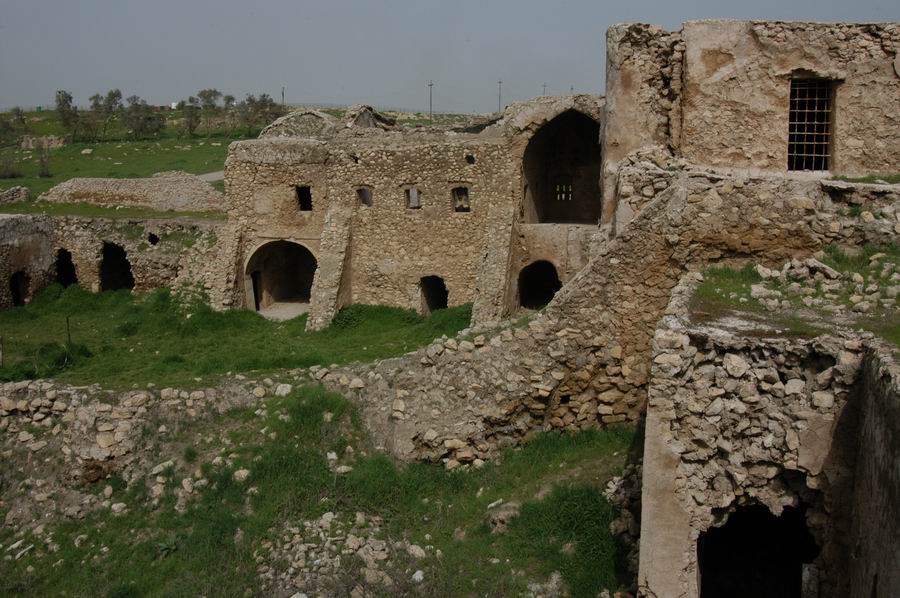 |
The monastery was built by Mar Elia who lived in Nisibis/Nisibin/Kamishli, prior to moving to Nineveh at the end of the sixth century. It is possible that Mar Elia’s move to the Nineveh plane was prompted by two factors, continuous struggle between Rome and Persia, on one hand, and the increase in the number of Christians in the plane of Nineveh and the surrounding area, perceived as a safe haven, on the other.
The Roman/Persian frontiers in Western Mesopotamia did not have fixed physical boundaries due to continuous military campaigns against each other, but most of the country was occupied or fell under the Persian dominance. It was a common occurrence that cities along the frontiers would change hands, from one side to another; whether by treaties or wars, depending on the relation between the two powers at the time. The shifting of territories would be followed by massive movement of peoples, as it happened when Nisibis was turned to Persia.
The case is analogues to St. Ephrim the Syrian, “Doctor of the Universal Church”, who he left his famous school in Nisibis and moved to Edissa/Urhai.
The movement of people from one side to anther was directly influenced by the state intolerance of a certain creed on its newly acquired territory. If the population of an acquired area is perceived as a threat or having closer ties or affinity to the other side, in this case the enemy, the people would be either pacified or deported across the border. The practice was implemented by both powers as a continuation of policy to reduce rebellion and implementation of ethnic cleansing.
Mar Elia’s Monastery has survived over 1500 years and it has changed ownership among the Churches of the Syriac speaking population. In the last century, the Monastery was managed and cared for by the Assyrian/Chaldean Catholic Church.
The surrounding landscape of the Monastery is abundant with rolling hills where bedrock is available and suitable for building material. A creek, Al Sahl, passes through which makes the location an ideal place for raising crops and sheep and a source of fresh water. The monastery has its own mineral spring that is good for drinking. In Spring time the area is lush green and it is suitable for growing different crops.
In the late 1940’s Iraq established a military camp at Al Ghazlani, Mu’skar Al Ghazlani, and the Monastery fell within the parameters of the camp. Within the Iraqi army in sight the worshipers who flocked the Monastery from all over the surrounding Christian villages ceased to come and visit the monastery, consequently it was abandoned and fell into ruins.
(There are indications that the Iraqi Army expelled the residents of the monastery for security reasons, without compensating the Church of its actions).
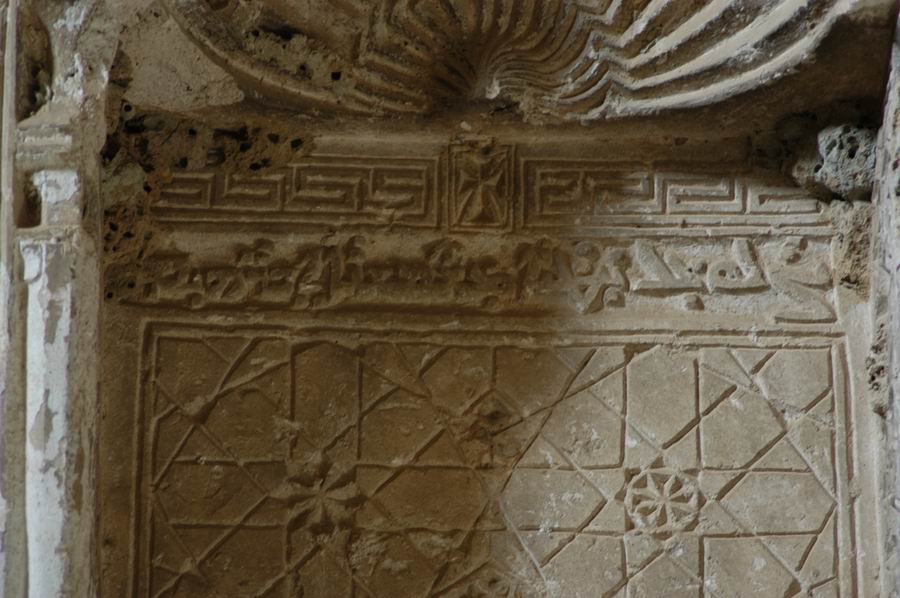 |
Assyrian script can be seen on the walls of the St. Elia Monastery. |
The monastery was destroyed in 1743 by Tahmaz Nadir Shah, and murdered all its occupants. In the 1700s Hormiz Alqoshnaya, an Assyrian from Alqosh village, rebuilt the Monastery with the same original stones [1].
The present structure consists of a church and a large rectangle courtyard 70x70 yards containing several single rooms.
Two sections of the structure, above and adjacent to the church, are double stories. A cave in the middle of yard leads to spring water, the only source of fresh water when the Monastery is under siege. The structure is surrounded by high walls and is accessible by a small (steel) door. On the south western side of the monastery there is a big cave that was probably used for a storage or second access to the spring water.
There is no cemetery visible in the area that might have some head stones with Syriac inscriptions to shed some lights on the occupants or residents of the monastery.
There are hundreds of sites in Iraq that are or have been abandoned and are left to decay. History will be forgotten if abundant and rich historical sites are not preserved for the future generations..
Notes:
1. See *Dr. Yousif Habbi, 'Bet Nahrain' magazine, 1974 Issue 7, p.2681.
Death for “Apostates” and “Sodomists”
Andrew G. Bostom M.D.
California
Courtesy of The American Thinker, 21 March 2006
This past week has provided two glaring examples of the pitfalls of allowing that “no law can be contrary to the beliefs and provisions of the sacred religion of Islam”, as per the new constitutions of the vox populi elected governments in Afghanistan and Iraq. With major input from the U.S. State Department, both constitutions installed Islam as the official state religion and made ancient Islamic religious law, Shari’a, a primary guiding source for these legal systems. As former federal prosecutor Andrew McCarthy noted, the constitutions,
…also contained some human rights provisions, which is what…enthusiasts said we should be focusing on rather than all that nettlesome religio-cultural stuff…The State Department maintained that it [the Afghanistan constitution] also contained strong human rights provisions and was thus becoming a framework for the emergence of a peaceful and vibrant democracy
Thus with grim predictability, an Afghan Muslim convert from Islam to Christianity, Abdul Rahman, was arrested, charged with “apostasizing” from Islam, and according to the March 19, 2006 statement of the presiding judge, Ansarullah Mawlavezada, faces the death penalty. Apostasizing from Islam to any other religion is punishable by death under the Shari’a. And as Ibn Warraq described in his unique study of Muslim apostates, the Shari’a mandates often fill in the “lacunae” of Islamic constitutions regarding punishment for apostasy from Islam. Mr. Mawlavezada explained that, although,
We are not against any particular religion in the world..in Afghanistan, this sort of thing is against the law…[apostasy from Islam] is an attack on Islam. ... The prosecutor is asking for the death penalty.
In an effort, one assumes, to convey his “Islamic reasonableness,” the Afghan prosecutor, Abdul Wasi, further noted
…that he had offered to drop the charges if Rahman changed his religion back to Islam, but the defendant refused.
According to a March 16, 2006 report from a London-based gay rights group, Grand Ayatollah Ali Al-Sistani, the supreme religious authority for Shi’ite Muslims in Iraq and an icon for Shi’a worldwide, has apparently decreed that gays and lesbians should be put to death “in the worst manner possible.” Confirmation of this claim is provided at Sistani’s own official website, specifically this page, item 5, from a question and answer section, which translates:
Q: What is the judgment on sodomy and lesbianism?
A: Forbidden. Those involved in the act should be punished. In fact, sodomites should be killed in the worst manner possible.*
Al-Sistani has been lionized as a moderate healing force in Iraq, worthy of consideration for a Nobel Peace Prize (such informal “nominations” coming from across the political spectrum, i.e., both the New York Times’ Tom Friedman, and National Review’s Richard Lowry). His frank “ruling” which sanctions the brutal murder of homosexuals, in conjunction with the good Ayatollah’s earlier pronouncements on the debasing uncleanliness of non-Muslims (i.e., his adherence to the orthodox Shi’ite doctrine of najis) might dampen his Nobel prospects—although one can’t be too sure in our moribund contemporary world.
Analyses of the debacles over the drafting of the Iraq Constitution and the delayed seating of Iraq’s elected Parliamentary government, ignore the fact that Iraqis have in fact tread this path before—with distressing results, culminating in massacres of the Assyrian Christians, and later the hideous Baghdad pogrom of its Jewish population in 1941. British Arabist S. A. Morrison wrote a revealing “hopeful” analysis in1935 which, even after the Assyrian massacres of 1933-34, smacks of delusional apologetics, particularly viewed in light of Iraq’s subsequent history, through 2006. Morrison’s essay was written following great expense of British blood and treasure, and more than a decade of military occupation. His conclusions (S.A. Morrison, “Religious Liberty in Iraq”, Moslem World, 1935, p. 128) regarding the British involvement in the “creation” of Iraq, sound depressingly familiar in light of the present U.S. predicament:
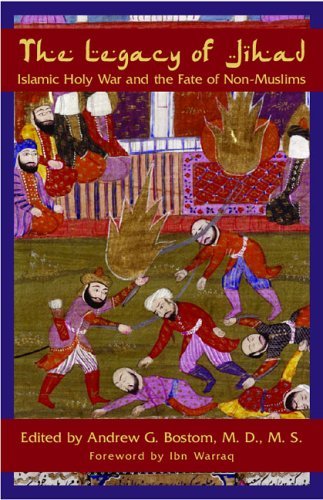 |
Iraq is moving steadily forward towards the modern conception of the State, with a single judicial and legislative system, unaffected by considerations of religion or nationality. The Millet system (i.e., the system of Ottoman dhimmitude), still survives but its scope is definitely limited. Even the Assyrian tragedy (a brutal series of murderous pogroms during which Iraqi Kurdish and Arab Muslims killed thousands of Assyrian Christians) of 1933 does not shake our faith in the essential progress that has been made. The Government is endeavoring to carry out faithfully the undertakings it has given, even when these run directly counter to the long cherished provisions of the Shari’a Law. But it is not easy; it cannot be easy in the very nature of the case, for the common people quickly to adjust their minds to the new legal situation, and to eradicate from their outlook the results covering many centuries of a system which implies the superiority of Islam over the non-Moslem minority groups. The legal guarantees of liberty and equality represent the goal towards which country is moving, rather than the expression of the present thoughts and wishes of the population. The movement, however, is in the right direction, and it may yet prove possible for Islam to disentangle religious faith from political status and privilege.
Clearly more than 70 years later, the Iraqi people still cannot seem
...to eradicate from their outlook the results covering many centuries of a system which implies the superiority of Islam over the non-Moslem minority groups…,
while Iraqi Islam remains unable to “...disentangle religious faith from political status and privilege.”
These disturbing current events—a prosecution for “apostasy” in Afghanistan, with a potential death sentence imposed, and the sanctioning of the brutal murder of homosexuals by Iraq’s most influential “moderate” cleric—are entirely consistent with the Shari’a. They underscore how Islamic societies must embrace the pluralistic spirit of the Western Enlightenment if they are to be meaningfully reformed. Muslim scholar Bassam Tibi’s observations are particularly apposite, and reveal what our objectives for Afghanistan and Iraq should be:
In the context of religious tolerance-and I write this as a Muslim- there can be no place…for Shari’a …Shari’a is diametrically opposed to secular constitutions formulated by the people… I hold out for the superiority of common sense over religious faith (i.e., absolute religious precepts); individual human rights (i.e., not collective human rights); secular democracy based on the separation of religion from politics; a universally accepted pluralism; and a mutually accepted secular tolerance. The acceptance of these values is the foundation of a civil society.
*I have had this translation of the original Arabic vetted and confirmed independently by three scholars of written Arabic.
 Andrew G. Bostom, MD, MS is the author of "The Legacy of Jihad" (click here). Andrew G. Bostom, MD, MS is the author of "The Legacy of Jihad" (click here).
|
Bravo
Assyrians at Their Best
|
|
Assyrian Youth Wins MTV Trip to Africa
Mesa Jajan, 20, is an Assyriology student at the University of Leiden in the Netherlands. She was born in Qamishli, Syria, and moved to Europe with her family when she was four. A couple of months ago she entered an MTV competition called Puma Africa for which she had to write a four-line poem. The winning prize was a VIP trip to watch the Africa Cup of Nations Soccer tournament in Egypt.
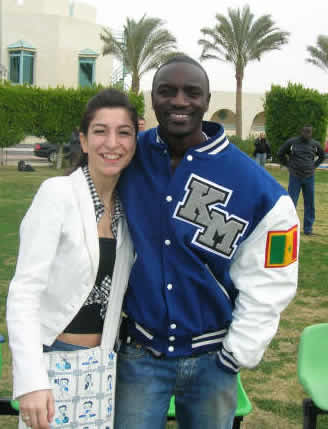 |
| Mesa Jajan and the R&B singer, Akron, during the African football tournaments. |
A month later Mesa received a phone call from MTV informing her that she had reached the final stage of the competition. She was invited to the MTV studios in London. There were ten finalists from around Europe and only four could win the trip.
In January an MTV film crew showed up at Mesa's residence to surprise her and to tell her that she had made it to the winners' circle.
On January 23 Mesa travelled to Cairo with two other winners – Alex from Norway and Sofian from Germany – to meet the other winner, Wandile from South Africa.
Mesa writes to Zinda: "We had a fantastic week! On the first day we visited the Pyramids of Giza and the Sphinx, where we did some camel riding, and the bazaar. The next day we went to the Senegalese training camp in al-Isma`iliya and after that we went to the match between Cameroon and Togo. Then on the third day we went to the Ivory Coast training camp and on that night we had dinner with the Ivory Coast team. We went to the Senegal versus Ghana match at Port Said on day four and on our final day we went to the packed match between Egypt and Ivory Coast. The stadium was jammed with 90,000 fans. It was incredible!"
The group was accompanied by the R & B singer Akon, originally from Senegal, as well as an MTV film crew. It was a week full of excitement. Mesa continues: "We were able to experience the Egyptian culture and the way of life, which of course included large doses of football!"
Mesa Jajan's winning poem was the following:
Africa stands for pure, it lays in its heart
Soccer stands for passion, right from the start
Together they create trust and the power to achieve
Let's go forward together because WE believe
The show has already been broadcast in several countries, including Germany, and at 7pm on March 22 it will be shown in Holland.
|
|
Thank You
The following individuals contributed to the publication of this issue:
|
| Dr. Matay Beth Arsan |
Holland |
| Mazin Enwiya |
Chicago |
| Dorina Golpashin |
California |
| Nahrain E. Kamber |
California |
| Joseph Tamraz |
Chicago |
|
ZINDA Magazine is published every week. Views expressed in ZINDA do not necessarily represent those of the ZINDA editors, or any of our associated staff. This publication reserves the right, at its sole discretion, not to publish comments or articles previously printed in or submitted to other journals. ZINDA reserves the right to publish and republish your submission in any form or medium. All letters and messages require the name(s) of sender and/or author. All messages published in the SURFS UP! section must be in 500 words or less and bear the name of the author(s). Distribution of material featured in ZINDA is not restricted, but permission from ZINDA is required. This service is meant for the exchange of information, analyses and news. Any material published in Zinda Magazine will not be removed later at the request of the sender. For free subscription to Zinda Magazine, send e-mail with your name, address, telephone number to: zcrew@zindamagazine.com.
ZINDA means "Spark of Fire" in modern Syriac (Assyrian); Zinda's Red Swoosh is a rendering of the seventh letter in the Assyrian alphabet, letter ZEN, and the first letter in the word "Zinda". For more information about the Assyrian culture and heritage write to Zinda Magazine.
Zinda Magazine™ Copyright © Zinda Inc., 1994-2006 - All Rights Reserved - www.zindamagazine.com |





